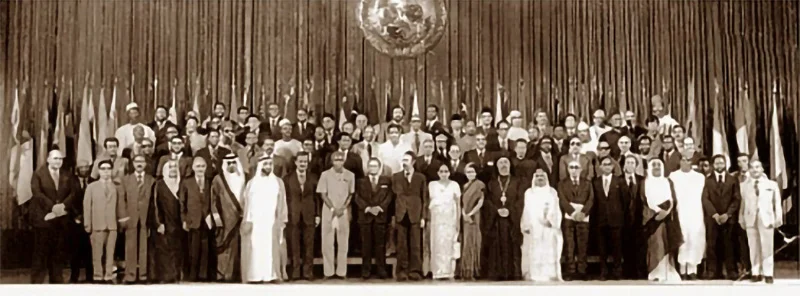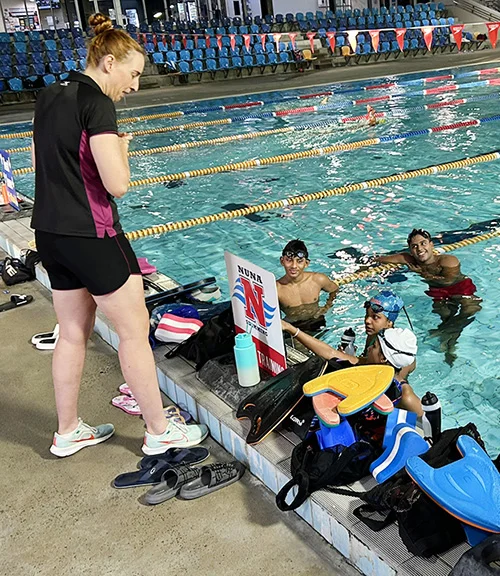Features
Revisiting Non-Alignment and Multi-Alignment in Sri Lanka’s foreign policy

 Former Minister Ali Sabry’s recent op-ed, “Why Sri Lanka must continue to pursue a non-aligned, yet multi-aligned foreign policy,” published in the Daily FT on 3 March, offers a timely reflection on Sri Lanka’s foreign policy trajectory in an increasingly multipolar world. Sabry’s articulation of a “non-aligned yet multi-aligned” approach is commendable for its attempt to reconcile Sri Lanka’s historical commitment to non-alignment with the realities of contemporary geopolitics. However, his framework raises critical questions about the principles of non-alignment, the nuances of multi-alignment, and Sri Lanka’s role in a world shaped by great power competition. This response seeks to engage with Sabry’s arguments, critique certain assumptions, and propose a more robust vision for Sri Lanka’s foreign policy.
Former Minister Ali Sabry’s recent op-ed, “Why Sri Lanka must continue to pursue a non-aligned, yet multi-aligned foreign policy,” published in the Daily FT on 3 March, offers a timely reflection on Sri Lanka’s foreign policy trajectory in an increasingly multipolar world. Sabry’s articulation of a “non-aligned yet multi-aligned” approach is commendable for its attempt to reconcile Sri Lanka’s historical commitment to non-alignment with the realities of contemporary geopolitics. However, his framework raises critical questions about the principles of non-alignment, the nuances of multi-alignment, and Sri Lanka’s role in a world shaped by great power competition. This response seeks to engage with Sabry’s arguments, critique certain assumptions, and propose a more robust vision for Sri Lanka’s foreign policy.
Sabry outlines five key pillars of a non-aligned yet multi-aligned foreign policy:
- No military alignments, no foreign bases: Sri Lanka should avoid entangling itself in military alliances or hosting foreign military bases.
- Economic engagement with all, dependency on none
: Sri Lanka should diversify its economic partnerships to avoid over-reliance on any single country.
* Diplomatic balancing
: Sri Lanka should engage with multiple powers, leveraging relationships with China, India, the US, Europe, Japan, and ASEAN for specific benefits.
- Leveraging multilateralism
: Sri Lanka should participate actively in regional and global organisations, such as UN, NAM, SAARC, and BIMSTEC.
- Resisting coercion and protecting sovereignty
: Sri Lanka must resist external pressures and assert its sovereign right to pursue an independent foreign policy.
While pillars 1, 2, and 5 align with the traditional principles of non-alignment, pillars 3 and 4 warrant closer scrutiny. Sabry’s emphasis on “diplomatic balancing” and “leveraging multilateralism” raises questions about the consistency of his approach with the spirit of non-alignment and whether it adequately addresses the challenges of a multipolar world.
Dangers of over-compartmentalisation
Sabry’s suggestion that Sri Lanka should engage with China for infrastructure, India for regional security and trade, the US and Europe for technology and education, and Japan and ASEAN for economic opportunities reflects a pragmatic approach to foreign policy. However, this compartmentalisation of partnerships risks reducing Sri Lanka’s foreign policy to a transactional exercise, undermining the principles of non-alignment.
Sabry’s framework, curiously, excludes China from areas like technology, education, and regional security, despite China’s growing capabilities in these domains. For instance, China is a global leader in renewable energy, artificial intelligence, and 5G technology, making it a natural partner for Sri Lanka’s technological advancement. Similarly, China’s Belt and Road Initiative (BRI) offers significant opportunities for economic development and regional connectivity. By limiting China’s role to infrastructure, Sabry’s approach risks underutilising a key strategic partner.
Moreover, Sabry’s emphasis on India for regional security overlooks the broader geopolitical context. While India is undoubtedly a critical partner for Sri Lanka, regional security cannot be addressed in isolation from China’s role in South Asia. The Chinese autonomous region of Xizang (Tibet) is indeed part of South Asia, and China’s presence in the region is a reality that Sri Lanka must navigate. A truly non-aligned foreign policy would seek to balance relationships with both India and China, rather than assigning fixed roles to each.
Sabry’s compartmentalisation of partnerships risks creating silos in Sri Lanka’s foreign policy, limiting its flexibility and strategic depth. For instance, by relying solely on the US and Europe for technology and education, Sri Lanka may miss out on opportunities for South-South cooperation with members of BRICS.
Similarly, by excluding China from regional security discussions, Sri Lanka may inadvertently align itself with India’s strategic interests, undermining its commitment to non-alignment.
Limited multilateralism?
Sabry’s call for Sri Lanka to remain active in organisations like the UN, NAM, SAARC, and BIMSTEC is laudable. However, his omission of the BRI, BRICS, and the Shanghai Cooperation Organisation (SCO) is striking. These platforms represent emerging alternatives to the Western-dominated global order and offer Sri Lanka opportunities to diversify its partnerships and enhance its strategic autonomy.
The BRI is one of the most ambitious infrastructure and economic development projects in history, involving over 140 countries. For Sri Lanka, the BRI offers opportunities for infrastructure development, trade connectivity, and economic growth. By participating in the BRI, Sri Lanka can induce Chinese investment to address its infrastructure deficit and integrate into global supply chains. Excluding the BRI from Sri Lanka’s foreign policy framework would be a missed opportunity.
BRICS and the SCO represent platforms for South-South cooperation and multipolarity. BRICS, in particular, has emerged as a counterweight to such Western-dominated institutions as the IMF and World Bank, advocating for a more equitable global economic order. The SCO, on the other hand, focuses on regional security and counterterrorism, offering Sri Lanka a platform to address its security concerns in collaboration with major powers like China, Russia, and India. By engaging with these organisations, Sri Lanka can strengthen its commitment to multipolarity and enhance its strategic autonomy.
Non-alignment is not neutrality
Sabry’s assertion that Sri Lanka must avoid taking sides in major power conflicts reflects a misunderstanding of non-alignment. Non-alignment is not about neutrality; it is about taking a principled stand on issues of global importance. During the Cold War, non-aligned countries, like Sri Lanka, opposed colonialism, apartheid, and imperialism, even as they avoided alignment with either the US or the Soviet Union.
Sri Lanka’s foreign policy, under leaders like S.W.R.D. Bandaranaike and Sirimavo Bandaranaike, was characterised by a commitment to anti-colonialism and anti-imperialism, opposing racial segregation and discrimination in both its Apartheid and Zionist forms. Sri Lanka, the first Asian country to recognise revolutionary Cuba, recognised the Palestine Liberation Organisation (PLO) and the Provisional Revolutionary Government of South Vietnam, supported liberation struggles in Africa, and opposed the US military base in Diego Garcia. These actions were not neutral; they were rooted in a principled commitment to justice and equality.
Today, Sri Lanka faces new challenges, including great power competition, economic coercion, and climate change. A truly non-aligned foreign policy would require Sri Lanka to take a stand on issues like the genocide in Gaza, the colonisation of the West Bank, the continued denial of the right to return of ethnically-cleansed Palestinians and Chagossians, the militarisation of the Indo-Pacific, the use of economic sanctions as a tool of coercion, and the need for climate justice. By avoiding these issues, Sri Lanka risks becoming the imperialist powers’ cringing, whingeing client state.
The path forward
Sabry’s use of the term “multi-alignment” reflects a growing trend in Indian foreign policy, particularly under the BJP Government. However, multi-alignment is not the same as multipolarity. Multi-alignment implies a transactional approach to foreign policy, where a country seeks to extract maximum benefits from multiple partners without a coherent strategic vision. Multipolarity, on the other hand, envisions a world order where power is distributed among multiple centres, reducing the dominance of any single power.
Sri Lanka should advocate for a multipolar world order that reflects the diversity of the global South. This would involve strengthening platforms like BRICS, the SCO, and the NAM, while also engaging with Western institutions like the UN and the WTO. By promoting multipolarity, Sri Lanka can contribute to a more equitable and just global order, in line with the principles of non-alignment.
Ali Sabry’s call for a non-aligned, yet multi-aligned foreign policy falls short of articulating a coherent vision for Sri Lanka’s role in a multipolar world. To truly uphold the principles of non-alignment, Sri Lanka must:
* Reject compartmentalisation
: Engage with all partners across all domains, including technology, education, and regional security.
* Embrace emerging platforms
: Participate in the BRI, BRICS, and SCO to diversify partnerships and enhance strategic autonomy.
* Take principled stands
: Advocate for justice, equality, and multipolarity in global affairs.
* Promote South-South cooperation
: Strengthen ties with other Global South countries to address shared challenges, like climate change and economic inequality.
By adopting this approach, Sri Lanka can reclaim its historical legacy as a leader of the non-aligned movement and chart a course toward a sovereign, secure, and successful future.
(Vinod Moonesinghe read mechanical engineering at the University of Westminster, and worked in Sri Lanka in the tea machinery and motor spares industries, as well as the railways. He later turned to journalism and writing history. He served as chair of the Board of Governors of the Ceylon German Technical Training Institute. He is a convenor of the Asia Progress Forum, which can be contacted at asiaprogressforum@gmail.com.)
by Vinod Moonesinghe
Features
‘Silent Majority’ abandoned to Long-suffering in regional conflicts

 With reports emerging that India has attacked some ‘sites’ in Pakistan and Pakistan-administered Kashmir, the question could be posed whether the stage has just been set for yet another costly India-Pakistan military conflict. Sensible opinion in South Asia could only hope that wise counsel would sooner rather than later come to prevail on both sides of the divide and that they would draw back from the brink of full-scale war.
With reports emerging that India has attacked some ‘sites’ in Pakistan and Pakistan-administered Kashmir, the question could be posed whether the stage has just been set for yet another costly India-Pakistan military conflict. Sensible opinion in South Asia could only hope that wise counsel would sooner rather than later come to prevail on both sides of the divide and that they would draw back from the brink of full-scale war.
The states concerned ought to know fully well the possible wide-ranging weighty consequences of another regional conflict. It should be plain to see that it would benefit none in the two theatres of confrontation, most particularly the relevant publics or the ‘Silent Majority’.
In fact, in connection with the mentioned initial military attacks, the Pakistani side has gone on record that some civilian lives have been lost. Such losses could burgeon in the event of full scale hostilities. These costs could of course be staggering and unimaginable in the event the nuclear option is resorted to by the sides, going forward.
Accordingly, the hope of the peace-loving world-wide is likely to be that India and Pakistan would give negotiations a chance and resolve their differences peacefully. It would be in the best interests of the world for the champions of peace to join their voices to that of UN chief Antonio Guterres and call on the sides to negotiate an end to their differences.
The utter helplessness and misery of the people of the Gaza ought to drive home afresh the horrors of war. Currently the news is that the Gazans are literally starving to death. Food and other essentials provided by UN agencies are reportedly being prevented by Israel from getting to the hapless people of Gaza. So dire is their situation that concerned quarters are calling on the compassionate worldwide to provide the Gazans with food, water and other essentials voluntarily. This SOS would need to be heeded forthwith.
Accordingly, it could be inferred that most formal arrangements, including those that are generally under the purview of the UN, geared to providing emergency humanitarian assistance to the needy, have, for all intents and purposes, been rendered ineffective in the Gaza. The UN cannot be faulted for this state of things; rather, Israel should be held accountable in the main for it.
The matter of accountability is central to the dramatic slide into lawlessness the world has been experiencing over the past few decades. As could be seen, International Law is no longer fully applicable in the conflict and war zones of the world because it is not being adhered to by many state and non-state aggressors. That the UN is hapless in the face of such lawlessness is plain to see.
We have of course the Middle East wherein International Law has fallen silent for quite a while. How could it be otherwise, when Israeli aggressions are being winked at by the US, for which the policy of backing Israel is almost sacrosanct?
Moreover, under President Donald Trump, it is difficult to see the US changing policy course on the Middle East. Trump made vague promises of bringing peace to the region in the run-up to his reelection but has done nothing concrete by way of peace-making. Consequently, complete lawlessness prevails in the Middle East. US policy towards Israel counts as another example of how the self- interest of US central administrations blinds them to their international obligations, in this case Middle East peace.
However, the commentator could be criticized as being biased if he holds only Israel responsible for what has befallen the Middle East. It has been the position of this columnist that Israel’s security needs should be taken cognizance of by its state and non-state adversaries in the Middle East and acted upon if the basis is to be laid for a durable Middle East peace. Inasmuch as Palestinian statehood must be guaranteed, the same should be seen as applicable to Israel. The latter too enjoys the right to live in a secure state of its own, unopposed by its neighbours.
The Ukraine of today is also sad testimony to the ill consequences of powerful, aggressor states wantonly disregarding International Law and its obligations. Nothing could justify Russia in invading Ukraine and subjecting it to a condition of Longsuffering. Clearly, Ukraine’s sovereignty has been violated and such excesses go to the heart of the current state of ‘International Disorder’. Of course the same stricture applies to the US in relation to its military misadventures in Afghanistan and Iraq, to name just two such modern examples.
There is no ducking the fact, then, that civilian publics in the mentioned theatres of war and outside, are being subjected to the worst suffering as a consequence of the big powers’ self-aggrandizement schemes and military misadventures. Longsuffering becomes the tragic lot of the people who have nothing to do with such unbridled power ambitions.
One would not be exaggerating the case if he states that civilian publics count for almost nothing in the present ‘International Disorder’. Increasingly it is becoming evident that from the viewpoint of the big powers and authoritarian governments the people are of little or no importance. Considering that self-aggrandizement is of the paramount interest for the former the public interest is coming to be seen as inconsequential.
Consequently, not much of a case could be made currently for the once almost reverentially spoken of ‘Social Contract’. For, the public interest does not count for much in the scrambles for power among the major powers who are seen at the popular level as the principal history-makers.
It is in view of the above that much is expected of India. Today the latter is a ‘Swing State’ of the first importance. Besides being a major democracy, it is one of the world’s principal economic and military powers. It possesses abundant potential to help to put things right in international politics. If there is one state in Asia that could help in restoring respect for International Law, it is India.
Considering the above, India, one believes, is obliged to bear the responsibility of keeping South Asia free of any more long-running, wasting wars that could aggravate the material hardships and socio-economic blights of the region. Thus, India would need to consider it imperative to negotiating peace with Pakistan.
Features
Memorable happening … Down Under

 Under the Global-Ise Australia Advanced Sports Development Programme, a delegation of 15 swimmers from Lyceum International School, Wattala, had the remarkable opportunity to train and experience high-performance sports development in Melbourne, Australia.
Under the Global-Ise Australia Advanced Sports Development Programme, a delegation of 15 swimmers from Lyceum International School, Wattala, had the remarkable opportunity to train and experience high-performance sports development in Melbourne, Australia.
The 10-day programme was carefully curated to offer intensive training, educational exposure, and cultural experiences for the young athletes.
The swimmers underwent specialised training through Swimming Victoria’s elite programme, held at some of Melbourne’s premier aquatic facilities.

Visit to Victorian Parliament
Each day began as early as 5:00 a.m. and continued until 7:00 p.m., ensuring a rigorous and enriching schedule that mirrored the standards of international competitive swimming.
Beyond training, the programme offered a wide array of experiences to broaden the students’ horizons.

Morning training
The tour group explored iconic landmarks such as the Victorian Parliament and the Melbourne Cricket Ground (MCG), and enjoyed shopping at Chadstone – The Fashion Capital. They also experienced the natural beauty of Victoria with visits to Yarra Valley Chocolaterie & Ice Creamery, and Cardinia Reservoir Park, where they observed kangaroos in their natural habitat.
An academic highlight of the tour was the group’s exclusive visits to three of Australia’s leading universities: the University of Melbourne, Monash University, and Deakin University. These visits aimed to inspire students and showcase the vast educational opportunities available in Australia.

Checking out the scene at Yarra Valley Chocolaterie & Ice Creamery
As part of the cultural immersion, Global-Ise hosted a traditional Australian BBQ at the Tim Neville Arboretum in Ferntree Gully. The students also enjoyed a variety of diverse culinary experiences each evening, further enriching their understanding of local and international food cultures.
The tour concluded with a celebratory dinner at the Spicy Wicket Restaurant, where each participant received a presentation in recognition of their involvement.

Enjoying an Aussie BBQ for lunch
The evening was made especially memorable by the presence of Pradeepa Saram, Consul General of Sri Lanka in Victoria.
Global-Ise Management—Ken Jacobs, Johann Jayasinha, and Dr Luckmika Perera (Consultant from the University of Melbourne)—did a magnificent job in planning and the execution of the advanced sports programme.

Coaches from Sri Lanka presenting a plaque to Global-Ise Management team
Ken Jacobs (centre), Johann Jayasinha, and Dr Luckmika Perera (on the right
Features
Bright, Smooth Skin

 Hi! How’s the beauty scene keeping with you?
Hi! How’s the beauty scene keeping with you?
Phew, this heat is awful but there is nothing that we can do about it.
However, there are ways and means to take care of your skin and I will do my best to help you in every way I can.
Well, this week, let’s go for a Bright, Smooth Skin.
Gram flour (also known as besan) is a traditional skincare ingredient known for its:
* Natural exfoliating properties.
* Ability to absorb excess oil.
* Gentle brightening and tan-removal effects.
* Suitability for all skin types, especially oily and acne-prone skin.
You will need 01–02 tablespoons gram flour (besan) and rose water, or raw milk, to make a paste.
You could add the following two as optional add-ins: A pinch of turmeric (for extra glow), and a few drops of lemon juice (for oily skin and pigmentation)
Add the gram flour to a small bowl and mix in the rose water (for oily/sensitive skin) or raw milk (for dry skin) slowly.
Stir well to make a smooth, spreadable paste—not too thick, not too runny.
Now apply this mixture, evenly, to your damp face and neck, and let it sit for 5–10 minutes (don’t let it dry completely if you have dry skin).
Gently massage in circular motions using wet fingers—this helps exfoliate.
Rinse off with lukewarm water, and then pat your skin dry.
Use it 02–03 times a week for best results.
Skin Benefits:
* Removes dirt, sweat, and oil without stripping natural moisture.
* Gently exfoliates dead skin cells, revealing smoother skin.
* Brightens the complexion and fades mild tanning.
* Helps clear clogged pores and reduce pimples.
* Leaves skin fresh and glowing—perfect for humid climates.
-

 News7 days ago
News7 days agoRanil’s Chief Security Officer transferred to KKS
-

 Opinion5 days ago
Opinion5 days agoRemembering Dr. Samuel Mathew: A Heart that Healed Countless Lives
-

 Business3 days ago
Business3 days agoAitken Spence Travels continues its leadership as the only Travelife-Certified DMC in Sri Lanka
-

 Business3 days ago
Business3 days agoLinearSix and InsureMO® expand partnership
-

 Latest News1 day ago
Latest News1 day agoNPP win Maharagama Urban Council
-

 Business7 days ago
Business7 days agoCCPI in April 2025 signals a further easing of deflationary conditions
-

 Features7 days ago
Features7 days agoExpensive to die; worship fervour eclipses piety
-

 Features5 days ago
Features5 days agoTrump’s economic missiles are boomeranging












